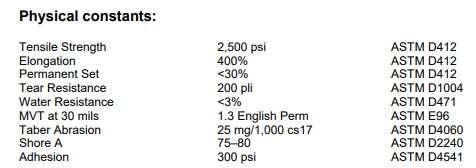
Neogard coatings are designed to protect your concrete decks, floor, roofs, and walls for years in harsh conditions. So, how do we confirm our coatings’ capabilities, and how do you know that they will perform as advertised?
We test them using industry-standard methods. Our internal lab, and trusted outside labs, test our individual products and systems to ensure that they will meet your demanding standards of performance.
Typical Standards Used by Neogard
The vast majority of our tests are conducted using ASTM International standards. Formerly known as the American Society for Testing and Materials, ASTM International develops and publishes voluntary consensus standards for materials, products, systems and services. ASTM has published over 12,000 standards in a wide range of industries, and has over 30,000 volunteer members in over 140 countries.
We use a few non-ASTM standards to test our products, but first we’ll look at the ASTM standards we frequently use. This is by no means a complete list, but it covers some of the more important and common tests we use on our coatings.
ASTM D412: “Standard Test Methods for Vulcanized Rubber and Thermoplastic Elastomers—Tension.” Almost all Neogard products are elastomeric; it’s one of the most, if not the most important property our products have. Many of our urethane coatings are tested using D412, which references other ASTM tests within the standard. Samples of the product are placed in a mechanical test device, which measures three elastomeric properties critical to maintaining a sound, watertight coating:
- Tensile Strength: The amount of stress a material can take while being pulled or stretched before breaking. Measured in pounds per square inch.
- Elongation: The percentage of change in length in a material before it breaks. Results are in a percentage of the original length of the sample.
- Permanent Set: An irreversible deformation that remains in a material after it has been subjected to stress. These results are also expressed as a percentage.
ASTM D2370: “Tensile Properties of Organic Coatings.” Similar to D412, this test method tests materials with different chemistry for tensile strength and elongation, but tests for stiffness—or, modulus of elasticity—instead of permanent set. Units of measurement are also the same as for D412. Our silicone and acrylic products are typically tested using this method.
ASTM D1004: “Tear Resistance (Graves Tear) of Plastic Film and Sheeting.” As the official description says, this method tests for the ability of a material to resist tearing. Samples with a 90° bend are stretched at 2” per minute until tearing; results are reported in pounds per linear inch (pli).
ASTM D4541: “Pull-Off Strength of Coatings Using Portable Adhesion Testers.” This one is all about how well a coating sticks to a surface, measured in pounds per square inch. A pull-off adhesion tester is attached to the coating, and the coating is pulled until it detaches from whatever is underneath—usually the substrate, but sometimes a primer or intermediate coat material. The higher the number, the better.
ASTM D4060: “Abrasion Resistance of Organic Coatings by the Taber Abraser,” We just call this one Taber Abrasion. It’s a measure of how much material—in grams—is lost by a coating on a flat surface when it’s abraded by a standardized grinding wheel. In minutes, this test can measure how much wear a coating will endure under typical usage. It’s especially useful for gauging the durability of traffic coatings and flooring.
ASTM E1980: “Calculating Solar Reflectance Index of Horizontal and Low-Sloped Opaque Surfaces.” I’ll let the U.S. Department of Energy’s Berkeley Lab define Solar Reflectance Index:
“The Solar Reflectance Index (SRI) is a measure of the roof's ability to reject solar heat, as shown by a small temperature rise. It is defined so that a standard black (reflectance 0.05, emittance 0.90) is 0 and a standard white (reflectance 0.80, emittance 0.90) is 100. For example, the standard black has a temperature rise of 90 deg. F (50 deg. C) in full sun, and the standard white has a temperature rise of 14.6 deg. F (8.1 deg. C). Once the maximum temperature rise of a given material has been computed, the SRI can be computed by interpolating between the values for white and black.”
Our roof coatings and some traffic coatings are tested for SRI. If you’re interested in energy savings, this is an important indicator of how the coating will perform.
ASTM D471: “Rubber Property—Effect of Liquids.” This broad testing method evaluates “the comparative ability of rubber and rubber-like compositions to withstand the effect of liquids.” It tests a material’s ability to retain its physical properties—mass, volume, tensile strength, elongation, hardness and so on—when subjected to exposure to or immersion in a liquid. It isn’t just a single test method; it’s an overarching standard in which other standards are used to test a material. Our concrete deck and roof coatings are typically tested for exposure to water, because they are frequently subjected to rain.
ASTM C957: “Standard Specification for High-Solids Content, Cold Liquid-Applied Elastomeric Waterproofing Membrane With Integral Wearing Surface.” This is a big one. Like D471, it is a broad standard which uses other, specific standards to test a complete coating system. Systems are tested for crack bridging, adhesion, chemical resistance, weathering resistance, abrasion resistance, and more. A system which passes this battery of tests will stand up to demanding conditions. Many of our traffic coating systems have been tested to this standard.
We also use standards from other industry groups and government agencies. Here are two of the most important:
ANSI A137.1: The American National Standards Institute (ANSI) released this standard in 2014, which determines the dynamic coefficient of friction, or DCoF, of a level surface. This standard was developed for ceramic tile, but can be used for almost any traffic-bearing material. The DCoF indicates how much grip a surface has by measuring the friction between the surface and a moving object; the test uses a hard rubber slider to simulate the heel of a dress shoe. Surfaces are tested when both dry and wet. The higher the number indicated on the test device, the better; the minimum for ceramic tile is 0.42.
JIS Z 2801: This Japanese Industrial Standard test determines the antimicrobial activity of plastics. It is an internationally recognized standard for testing surfaces to determine if they resist growth of microbes. It is an essential test for flooring materials, especially those used in kitchens, laboratories, medical facilities, or anywhere cleanliness is paramount. Many of our floor coatings have been tested using this standard.
Where to Find Neogard Product Test Results
Our Product Data Sheets (PDS) have test results in the physical constants section, located on the first page. The test name, result, and test standard are all shown, as in this example taken from the 7430 aromatic urethane PDS:

If you’re looking for a test not shown on the PDS, contact your Neogard Account Manager.
Test results for full systems are included on our system Guide Specifications, in Part 2.3, Material Performance Criteria. Following the properties for each coating in the system, we list any test standards passed by the complete system.
Have confidence in Neogard coatings and systems. We test our products to rigorous, internationally recognized standards, ensuring that your concrete decks, floors, roofs, and walls will be protected and look great for years to come. Contact your area’s Neogard Account Manager today.